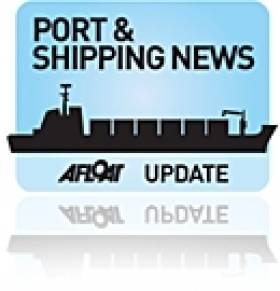Displaying items by tag: CLnd RoRo Shipping
#DorsetsDublinDebut – A sister of Anvil Point, the last ship to be built in Belfast by Harland & Wolff in 2003, the Dorset docked in Dublin Port last Friday having entered service for Colbelfret's (CLnD Ro-Ro) service from Zeebrugge, writes Jehan Ashmore.
Longstone since renamed Dorset, along with a sister Beachy Head, having been operated by Foreland Shipping were sold in April to C-Bulk Shipping, a subsidiary of the CLnd (Compagnie Luxemburgeoise de navigation SA).
Since spring 2013, the pair become surplus to the UK's Ministry of Defence (MoD) requirements as part of a Private Finance Initiative contract involving all six 'Point' class sisters.
The 23,235 tonnes ro-ro cargoship, having ceased a charter-contract to the MoD's Strategic Sealift command, required her to be ready in reserve to transport military equipment, vehicles and supplies in time of conflict.
Prior to the establishment of the Strategic Sealift, such difficulties were encountered by the MoD in securing such ships during the Gulf Wars.
It is understood that the conditions of the Private Finance Initiative of the Strategic Sealift contract had allowed for two of the six ships to be chartered for commercial purposes but available for armed forces given 30 days-notice.
A case in point being the charter of Longstone to that of DFDS Seaways, in which she ran the only ro-ro link between Scotland and Europe by serving on the North Sea route of Rosyth-Zeebrugge.
Despite her latest career change and guise as Dorset, it seems at least for now she that she is running out of the same Belgium port.
The 193m long Dorset which can handle 180 trailers, had made her inaugural Zeebrugge-Dublin sailing that is scheduled for a passage of 36 hours. Upon arrival in Dublin Bay, she took up a pilot from the cutter Liffey and berthed at the port's No. 2 link-span within Alexandra Basin East.
Fleetmate, Mazarine, the leadship of six German built con-ro sisters had previously docked in Dublin the night before having sailed on CLnd's second service from Rotterdam, taking slightly longer by 38 hours.
The ships on both routes are operated by CLnD whose Mazarine made her maiden voyage to Dublin Port and from where she was named in 2009.
The occasion was also notable as the CLnD 'Motorways of the Sea' routes are the first direct ro-ro freight service linking the Irish capital to Belgium and the Netherlands.
Mazarine carries double-stacked (854 TEU Mafi-container) cassettes, trailers, car and trucks across 3 kms of freight lane decks.
The decision to dispose of the Point pair followed a MoD review in 2011 of its Strategic Sealift requirements that has reduced this capability to the remaining quartet of Point sisters.
Of the four, Hartland Point, is the only other sister asides Anvil Point to have come from the yard of Harland & Wolff.
This left the rest of the series to be built in Germany, from the yard of FGS which as previously reported built CalMac's latest newbuild 'flagship' car ferry Loch Seaforth. She returned to her Scottish base of Inch Green yesterday after latest sea-trials.
Those attending the annual Southampton Boat Show held on Mayflower Park, may of noted on the far side of the River Test is a jetty. This is a UK government military facility at Marchwood Military Port, where Anvil Point and Eddystone are currently based on duty.
Finally is the Hurst Point which represents the sixth of the Point Class series. Likewise of Longstone (Dorset) she was commissioned for Andrew Weir Shipping (AWSR), the original owners of these ships.





























































